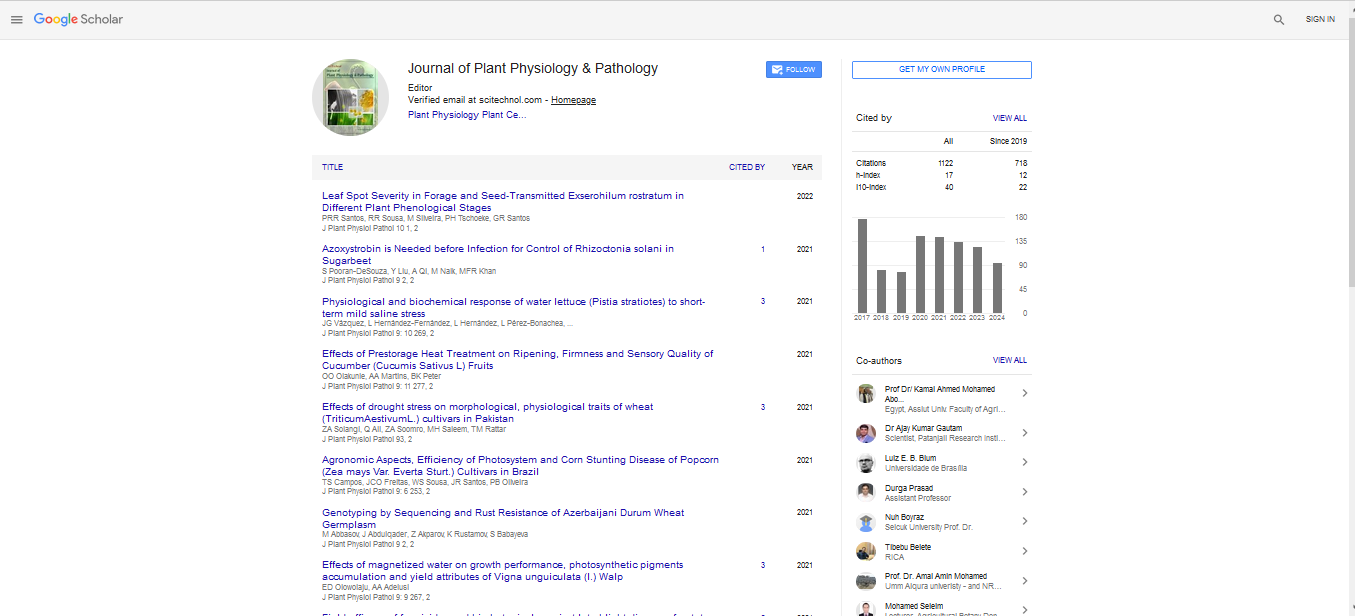Commentary, J Plant Physiol Pathol Vol: 12 Issue: 6
The Role of Insect Vectors in the Epidemiology of Cucumber Mosaic Virus
Wang Sheng*
1Department of Plant Sciences, University of Tennessee, Knoxville, USA
*Corresponding Author: Wang Sheng,
Department of Plant Sciences, University
of Tennessee, Knoxville, USA
E-mail: wang.sheng@utk.edu
Received date: 27 October, 2024, Manuscript No. JPPP-24-151668;
Editor assigned date: 29 October, 2024, PreQC No. JPPP-24-151668 (PQ);
Reviewed date: 13 November, 2024, QC No. JPPP-24-151668;
Revised date: 21 November, 2024, Manuscript No. JPPP-24-151668 (R);
Published date: 29 November, 2024, DOI: 10.4172/2329-955X.1000380
Citation: Sheng W (2024) The Role of Insect Vectors in the Epidemiology of Cucumber Mosaic Virus. J Plant Physiol Pathol 12:6.
Description
Cucumber Mosaic Virus (CMV) is a significant viral pathogen affecting a wide range of plants, particularly cucurbits, including cucumbers, melons and squash. The epidemiology of CMV is heavily influenced by insect vectors, primarily aphids, which facilitate the virus's transmission from infected to healthy plants. Understanding the role of these insect vectors in the spread of CMV is vital for developing effective management strategies to alleviate the virus's impact on agriculture. This paper discuss the mechanisms of CMV transmission by insect vectors, the factors influencing vector behavior and population dynamics and the implications for disease management.
Aphids acquire the virus while feeding on infected plants, during which they ingest the virus particles. Subsequently, they can transmit the virus to healthy plants within minutes of feeding, making those highly efficient vectors. Temperature and humidity plays an important roles in aphid population dynamics. Warmer temperatures and higher humidity levels can enhance aphid reproduction and survival rates. Additionally, environmental stressors, such as drought, can drive aphids to seek out host plants, increasing the likelihood of CMV transmission. The presence of susceptible host plants is vital for aphid populations. In agricultural settings, monoculture practices can lead to the rapid spread of CMV as aphids migrate between contiguous crops. Crop rotation and intercropping with non-host species can help disrupt aphid populations and reduce virus transmission. Healthy and infected plants emit different Volatile Organic Compounds (VOCs), which can attract aphids. Infected plants may emit VOCs that signal their suitability as hosts, prompting aphids to migrate toward them. Understanding these attractants can inform management strategies, such as trap cropping or deploying repellents. The feeding behavior of aphids also impacts CMV transmission. For instance, aphids tend to feed on the tender young growth of plants, which is often where CMV symptoms first manifest. Their feeding habits can influence the spread of the virus within and between crops. Predators and parasitoids of aphids can significantly influence aphid populations and their ability to transmit CMV. Introducing or conserving beneficial insects can help manage aphid populations and reduce the spread of the virus. Understanding the role of insect vectors in the epidemiology of CMV provides essential insights for developing effective management strategies. Integrated Pest Management (IPM) combining cultural, biological and chemical control methods can help manage aphid populations. Strategies may include monitoring aphid populations, using resistant plant varieties and applying insecticides when thresholds are met. Employing beneficial insects to control aphid populations can also be effective. Farmers can implement crop rotation, intercropping and sanitation measures to reduce the risk of CMV transmission. Maintaining diversity in plant species can help disrupt aphid populations and lower the incidence of CMV. Regular monitoring of aphid populations and CMV symptoms is vital for early detection and intervention. Employing yellow sticky traps can help monitor aphid populations and provide data for informed decisionmaking. Developing and planting CMV-resistant cultivars can significantly reduce the impact of the virus. Breeding programs focused on enhancing genetic resistance to CMV can provide longterm solutions for growers. Educating farmers and agricultural workers about CMV, its transmission dynamics and management strategies is essential for effective control. Extension services can provide training programs to increase awareness and promote best practices.
Insect vectors, particularly aphids, play a pivotal role in the epidemiology of Cucumber Mosaic Virus. Their ability to acquire and transmit the virus rapidly influences its spread and impact on cucurbit crops. Environmental conditions, host plant availability and insect behavior are important factors that shape aphid populations and their transmission dynamics. By understanding these relationships, agricultural stakeholders can implement integrated management strategies to lessen the threat of CMV, ensuring the sustainability of cucurbit production. Ongoing research into the interactions between CMV, aphid vectors and host plants will further enhance our ability to manage this significant agricultural challenge effectively.
 Spanish
Spanish  Chinese
Chinese  Russian
Russian  German
German  French
French  Japanese
Japanese  Portuguese
Portuguese  Hindi
Hindi 
